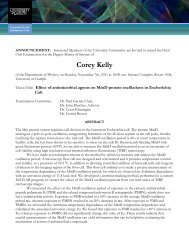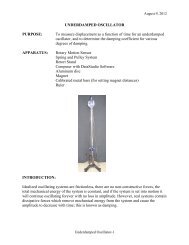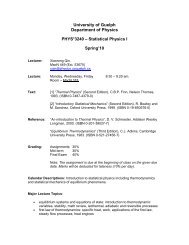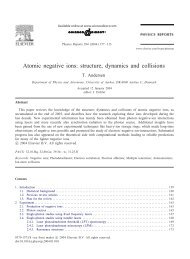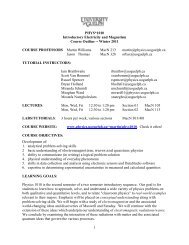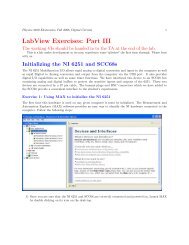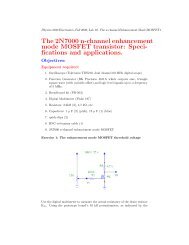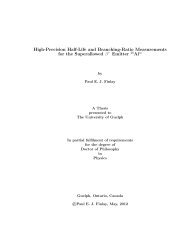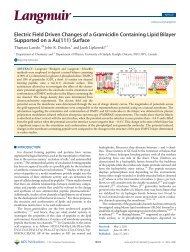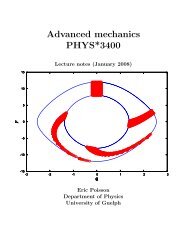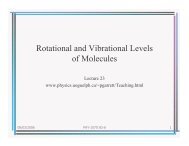Geant4 Simulations for the Radon Electric Dipole Moment Search at
Geant4 Simulations for the Radon Electric Dipole Moment Search at
Geant4 Simulations for the Radon Electric Dipole Moment Search at
Create successful ePaper yourself
Turn your PDF publications into a flip-book with our unique Google optimized e-Paper software.
NMR techniques, and supplementing standard NMR techniques with a strong electric<br />
field provides an excellent method to search <strong>for</strong> an EDM. The process of measuring<br />
an EDM using <strong>the</strong>se techniques begins with polarizing <strong>the</strong> nuclei.<br />
Nuclear spin polariz<strong>at</strong>ion of noble gases is possible through spin-exchange collisions<br />
with optically pumped alkali-metals [28, 29, 30]. This method has been shown<br />
to be successful in <strong>the</strong> polariz<strong>at</strong>ion of radon isotopes ( 209,223 Rn) <strong>at</strong> <strong>the</strong> ISOLDE isotope<br />
separ<strong>at</strong>or <strong>at</strong> CERN [31]. Similar polariz<strong>at</strong>ion studies have been tested and are<br />
continuing to be developed <strong>for</strong> <strong>the</strong> RnEDM experiment <strong>at</strong> TRUMF.<br />
2.3.1 Optical Pumping of Rubidium Vapour<br />
Alkai-metals are commonly used <strong>for</strong> optical pumping since <strong>the</strong>y have only one<br />
valence electron. This electron can be easily excited with photon wavelengths conveniently<br />
in <strong>the</strong> range where diode lasers are available. The measurement cell in<br />
<strong>the</strong> RnEDM appar<strong>at</strong>us will contain an optical pumping region, containing n<strong>at</strong>ural<br />
rubidium ( 85,87 Rb) vapour, radon <strong>at</strong>oms and roughly 1 <strong>at</strong>m of N 2 gas. The n<strong>at</strong>ural<br />
rubidium vapour is <strong>the</strong> alkali-metal used to polarize <strong>the</strong> radon nuclei through spinexchange<br />
collisions and <strong>the</strong> N 2 gas acts as a buffer. The n<strong>at</strong>ural rubidium ( 85,87 Rb)<br />
<strong>at</strong>oms have odd-A nuclei and <strong>the</strong>re<strong>for</strong>e have a non-zero nuclear spin (I) which complic<strong>at</strong>es<br />
its level structure. To illustr<strong>at</strong>e <strong>the</strong> process of optical pumping we will first<br />
consider a much simpler <strong>at</strong>om with no nuclear spin.<br />
Consider <strong>the</strong> 4 He + ion, which is similar to <strong>the</strong> hydrogen <strong>at</strong>om without <strong>the</strong> nuclear<br />
spin. The electron can be in its ground st<strong>at</strong>e (1S 1/2 ), or given enough energy, it can<br />
occupy <strong>the</strong> first excited st<strong>at</strong>e (2P 1/2 ). Placing this <strong>at</strong>om in an external magnetic field<br />
will cause <strong>the</strong> energy levels to spilt, known as <strong>the</strong> Zeeman effect. This is illustr<strong>at</strong>ed in<br />
Figure 2.3. Both energy levels have J = 1/2; in <strong>the</strong> presence of a magnetic field <strong>the</strong><br />
17



